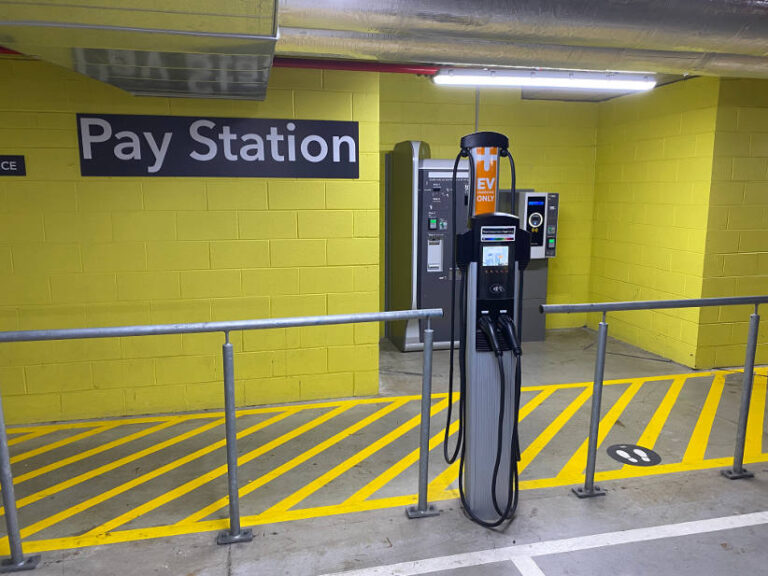As Australian fleets transition to electric vehicles, building a reliable and cost-effective charging strategy has become just as important as choosing the right vehicles. Traditionally, public charging has sat at the top of the so-called charging pyramid — a backup solution after onsite and home charging. But with advancements in pricing, access, and software integration, public charging is starting to play a more prominent role in smart fleet strategies.
Thanks to time-of-day pricing, widespread availability, and new tools for monitoring and reimbursement, public charging is no longer a premium-priced last resort. When used strategically, it can offer cost parity with home or depot charging — and even become a cost-saving opportunity.
“Public charging is no longer the backup plan,” said Austin Devaney, National Sales Manager at EVSE. “With the right network and data visibility, it can become a smart and cost-efficient part of a fleet’s charging strategy.”
Rethinking the Charging Pyramid
The charging pyramid is a framework that helps organisations prioritise how and where their vehicles should be charged. But unlike traditional pyramids where the most important items sit at the top, in this case the foundation sits at the bottom — and that’s onsite or depot charging.
- Onsite Charging – The foundation. Most cost-effective and controllable.
- Home Charging – Offers flexibility for employees who take vehicles home.
- Public Charging – Sits at the top. Less predictable, but increasingly important for operational flexibility.
Public charging is often viewed as the least desirable because of higher costs, inconsistent access, and limited control. But Devaney says that thinking is now out of date.
“With dynamic pricing and better integration, public charging can be just as cost-effective as other options — especially when charging is done during the day at the right location,” he said.
The Impact of Time-of-Day Pricing
One of the key developments changing the economics of public charging is time-of-day billing — a feature now available from several public charging networks .
“You can bill at different times of the day. You can do scheduled billing and incentivise people to charge during off-peak hours,” said Devaney.
This means that during the day, when grid demand is low and solar generation is high, fleets can access discounted charging rates. For many businesses, this makes public charging cheaper than reimbursing home energy costs or investing in additional depot infrastructure.
Real-World Applications for Fleets
Fleet vehicles rarely sit still. Sales representatives, service technicians, and field teams spend much of their day on the road — and they stop frequently for deliveries, lunch breaks, or client meetings. Public charging offers an opportunity to “charge where you park.”
“Exploren (the EVSE public charging network) has over 1,500 ports around the country,” Devaney explained. “At shops, universities, hospitals — locations where your drivers are already stopping. It changes the way people think about fuelling.”
With time-of-day pricing, drivers can top up at a lower cost during normal work hours — rather than waiting until they get home and plugging in at higher residential rates, or relying on constrained depot charging windows.
The Benefits of Public Charging for Fleet Operations
Incorporating public charging into the fleet mix brings several operational and financial benefits:
- Cost Parity or Savings: Time-of-day pricing can bring public charging rates in line with home and depot costs — or even lower.
- Increased Flexibility: Enables support for more mobile roles and regions where depot or home charging isn’t viable.
- Load Relief: Reduces pressure on depot infrastructure, avoiding costly upgrades.
- Simple Reimbursement: Charging data can be tracked and can be exported for driver reimbursement or consolidated fleet billing.
- ESG Reporting: Every public charge is recorded and visible, helping meet Scope 2 and Scope 3 emissions tracking obligations.
A Smarter Charging Strategy
Devaney suggests that forward-thinking organisations now treat public charging as a strategic enabler, rather than an emergency option.
“It’s about integrating charging into daily routines. If your driver stops at a shopping centre for 45 minutes, that’s 100km of range added at a discounted daytime rate — and they didn’t waste any time doing it,” he said.
This smarter approach allows organisations to design trip-based charging strategies, where drivers plug in during scheduled downtime instead of making special stops or returning to base.
Tips for Using Public Charging Effectively
To make the most of public charging in your EV strategy, consider the following:
- Plan around charging zones: Identify explore charging locations along common routes.
- Educate drivers: Help employees understand time-of-day pricing and how to plug in efficiently.
- Track and report: Use integrated software to capture public charging data for costs and carbon tracking.
- Balance your mix: Use public charging to relieve depot pressure and support drivers without access to home charging.
- Monitor trends: Evaluate public usage patterns and adapt your strategy as your fleet grows.
Public Charging Has Earned Its Place
Public charging isn’t replacing depot or home charging — it’s complementing them. As costs fall, networks grow, and software tools improve, public charging is becoming a key part of a well-rounded fleet charging strategy.
For Finance Managers, it offers cost control. For Sustainability Managers, it delivers ESG transparency. And for Fleet Managers, it solves the real-world complexity of keeping vehicles on the road — no matter where they go.
When integrated into the charging pyramid with the same planning and oversight given to onsite and home charging, public charging is no longer a gap filler — it’s a strategic asset.







